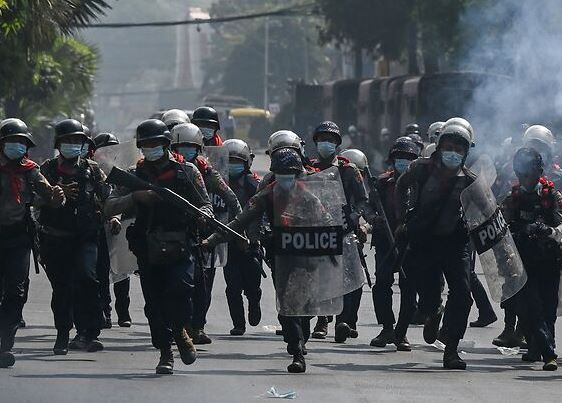Kolkata: Some internal memos of the Tatmadaw (Myanmar Army) indicate that the troops are under orders to ruthlessly stamp out protests and kill anyone opposing the law enforcers by force.
The revelations comes when Tatmadaw chief Senior General Min Aung Hlaing is meeting ASEAN leaders in Jakarta, when they pushed Gen Hlaing to commit his forces will not kill protesters and control military brutalities.
The Myanmar military chief avoided giving any straight commitment but reportedly promised his forces will try to control the violent response to the extent possible. But internal Taymadaw memos accessed by top diplomatic sources and made available to some mediapersons gives a different story.
“You must annihilate them when you face them,” reads an instruction dated April 11, because “rioters (the military’s euphemism for anti-regime protesters) have gone from peaceful demonstration to the level of armed conflict.”
“Officers at all levels have to follow these instructions strictly,” the memo originating from the army headquarters said. This seems to legitimise the brutal April 12 massacre of 82 people in one day in Bago, a city north of Yangon.
Soldiers and police indiscriminately fired live ammunition on protesters and even used rifle grenades to destroy roadblocks fortified with sandbags by agitators. Another high-level memo was distributed from army headquarters to all military formations two days after the Bago massacre on April 14.
It reads : “All the emergency security forces must be weaponized fully and systematically” as “riots may extend to your control area,” citing ongoing protests in “every township in Sagaing, Mandalay, Yangon and Bago regions and in Mon State.”
The formation of the armed insurgent group Federal Army, first reported by IANS , seems to have unnerved the Tatmadaw. The Federal Army wants to organise retaliatory attacks against Tatmadaw officers and military informers. Their first batch of recruits are reportedly receiving military training in bases of some ethnic rebel armies.
The military junta has been condemned worldwide for brutal atrocities against their own citizens and using unacceptable levels of force agsinst largely peaceful protests. Coup leader Senior General Min Aung Hlaing has been dubbed “murderer-in-chief” by many people online, as his troops have killed more than 700 people so far.
The regime justifies its use of force to stop what it dubs as “rioting”.
It refers to sporadic use of Molotov cocktails and air guns by protesters to justify violent repression, but the reality is different.
Citizens say the regime’s brutal repression has prompted some protesters to take up crude weapons such as homemade firebombs or rudimentary hunting rifles to hit back, though the protests across the country have been largely peaceful.
Most civilians deaths so far took place prior to the “annihilate them” order, but diplomats fear this shoot-to-kill “instruction” could further worsen .
The Tatmadaw has also recalled some battle-hardened commanders to the cities from remote battlefields in ethnic areas to quell the peaceful protests.
Vice Senior General Soe Win along with hardline regional commanders and Lieutenant General Than Hlaing, the Deputy Home Affairs Minister, are behind the brutal massacres.
Both commamders are now on EU and US sanctions lists.
Respected Burmese journal ‘Irrawaddy’ says that top Tatmadaw commanders , motivated by a mixture of deeply entrenched economic interests, a desire for political power and a misplaced sense of patriotism, are feeding rank-and-file soldiers and their families a steady diet of intimidation and propaganda, using psychological warfare tactics to keep them in line and hold the institution together.
The military on April 16 issued a warning to its field units that “foreign as well as domestic media are criticizing economic, political, social, religious and human rights issues of our government.”
It extorted “all responsible persons at all level of forces to prohibit troops and families from listening to the media and explain to them at least twice a week that such broadcasts are lies.”
Long before the order was issued, senior commanders had already banned mid-ranking officers from using Facebook, the country’s most popular social media platform.
That was meant to isolate them from the outside world and daily events in Myanmar.
On April 17, the military’s high command instructed all units “not to allow strangers to come into the military camps or surrounding areas.”
In the ethnic states, the army headquartets told field formations on April 12 that “ceasefire armed groups are not officially organised by the State” and emphasized that the Myanmar military “is the only legal armed force” and “has to work for democracy and development with full strength.”
It further stated that the military “really wants peace and its main role is defending the country.”
The message ends with the exhortation that “the above opinion must be explained to all the troops.”
